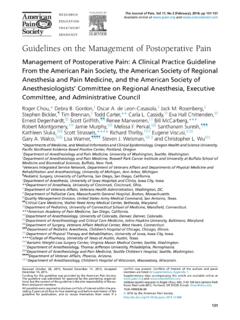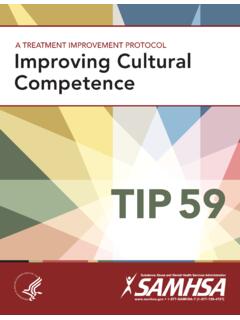Transcription of The Criminology of White-Collar Crime
1 Sally S. Simpson David Weisburd Editors The Criminology of White-Collar Crime 1 23. The Criminology of White-Collar Crime The Criminology of White-Collar Crime Sally S. Simpson Editor University of Maryland, College Park, MD. David Weisburd Editor Hebrew University, Jerusalem, Israel; George Mason University, Manassas, VA. 123. Editors Sally S. Simpson David Weisburd University of Maryland Hebrew University College Park, MD Jerusalem, Israel George Mason University Manassas, VA. ISBN 978-0-387-09501-1 e-ISBN 978-0-387-09502-8. DOI Library of Congress Control Number: 2008942519. c Springer Science+Business Media, LLC 2009. All rights reserved. This work may not be translated or copied in whole or in part without the written permission of the publisher (Springer Science+Business Media, LLC, 233 Spring Street, New York, NY 10013, USA), except for brief excerpts in connection with reviews or scholarly analysis.
2 Use in connection with any form of information storage and retrieval, electronic adaptation, computer software, or by similar or dissimilar methodology now known or hereafter developed is forbidden. The use in this publication of trade names, trademarks, service marks, and similar terms, even if they are not identified as such, is not to be taken as an expression of opinion as to whether or not they are subject to proprietary rights. Printed on acid-free paper Contents Part I Theoretical Perspectives on Crime Introduction .. 3. Sally S. Simpson and David Weisburd Understanding Criminogenic Corporate Culture: What White-Collar Crime Researchers Can Learn from Studies of the Adolescent Employment Crime Relationship .. 15. Robert Apel and Raymond Paternoster General Strain Theory and White-Collar Crime .. 35. Robert Agnew, Nicole Leeper Piquero, and Francis T. Cullen Part II Emergent Themes and Methodological Issues Persistent Heterogeneity or State Dependence?
3 An Analysis of Occupational Safety and Health Act Violations .. 63. Sally S. Simpson and Natalie Schell White-Collar Crimes and the Fear of Crime : A Review .. 79. Michael Levi The Role of Organizational Structure in the Control of Corporate Crime and Terrorism .. 111. Laura Dugan and Carole Gibbs Globalization and White-Collar Crime .. 129. Peter Grabosky Developmental Trajectories of White-Collar Crime .. 153. Nicole Leeper Piquero and David Weisburd v vi Contents Part III Crime Prevention and Control White-Collar Crime from an Opportunity Perspective .. 175. Michael L. Benson, Tamara D. Madensen, and John E. Eck Self-Regulatory Approaches to White-Collar Crime : The Importance of Legitimacy and Procedural Justice .. 195. Tom R. Tyler Index .. 217. Contributors Robert Agnew Department of Sociology, 1555 Dickey Drive, Emory University, Atlanta, GA 30322, USA. Robert Apel School of Criminal Justice, University at Albany, SUNY 135 Western Avenue, Albany, NY, USA.
4 Michael L. Benson University of cincinnati , cincinnati , OH, USA. Francis T. Cullen University of cincinnati , cincinnati , OH, USA. Laura Dugan Department of Criminology and Criminal Justice, The University of Maryland, College Park, MD, USA. John E. Eck University of cincinnati , cincinnati , OH, USA. Carole Gibbs School of Criminal Justice and Department of Fisheries and Wildlife, Michigan State University, East Lansing, MI 488, USA. Peter Grabosky ARC Centre of Excellence in Policing and Security, Regulatory Institutions Network, Research School of Pacific and Asian Studies, Australian National University, Australia Michael Levi Cardiff University, Wales, UK. Tamara D. Madensen University of Nevada-Las Vegas, Las Vegas, Nevada, USA. Raymond Paternoster Department of Criminology and Criminal Justice, University of Maryland, 2220 LeFrak Hall, College Park, MD, USA. Nicole Leeper Piquero Virginia Commonwealth University, Richmond, VA, USA.
5 Natalie Schell Department of Criminology and Criminal Justice at the University of Maryland/College Park, MD, USA. Sally S. Simpson Department of Criminology and Criminal Justice at the University of Maryland/College Park, MD, USA. vii viii Contributors Tom R. Tyler Department of Psychology, New York University, New York, NY, USA. David Weisburd The Hebrew University, Jerusalem, Israel; George Mason University, Manassas, VA, USA. About the Authors Robert Agnew is Samuel Candler Dobbs Professor of Sociology and Chair of the Sociology Department at Emory University. He has published four books and ap- proximately 70 articles on the causes of Crime and delinquency, with his most recent books being Juvenile Delinquency: Causes and Control (Oxford University Press, 2009), Why Do They Do It? A General Theory of Crime and Delinquency (Oxford University Press, 2005), and Pressured Into Crime : An Overview of General Strain Theory (Oxford University Press, 2006).
6 He is best known for his development of general strain theory, one of the leading theories of Crime and delinquency. He has served as Associate Editor of Theoretical Criminology and on the editorial boards of Criminology , Social Forces, and other journals. He has been active in many pro- fessional organizations and groups dealing with Crime and delinquency. And he is a Fellow of the American Society of Criminology . Robert Apel received his from the University of Maryland in 2004 and is currently Assistant Professor in the School of Criminal Justice at the University at Albany, State University of New York. His research interests include employ- ment and labor markets, incarceration and reentry, violence and injury, and applied econometrics. He is the Principal Investigator of a grant from the National Institute of Justice to study the causal impact of first-time incarceration on life outcomes in late adolescence and early adulthood.
7 His recent publications appear in Crimi- nology, Crime and Delinquency, Journal of Quantitative Criminology , and Justice Quarterly. Michael L. Benson is Professor of Criminal Justice at the University of cincinnati . Writing mainly in the areas of White-Collar and corporate Crime , he has published in numerous journals, including Criminology , Justice Quarterly, Journal of Research and Delinquency, American Sociological Review, American Journal of Sociology, and Social Problems. He received the Outstanding Scholarship Award of the Soci- ety for the Study of Social Problems Division on Crime and Juvenile Delinquency for his coauthored book, Combating Corporate Crime : Local Prosecutors at Work. His most recent book is Corporate Crime Under Attack: The Fight to Criminalize Business Violence. With Sally Simpson, he is currently completing a book on white - collar Crime from an opportunity perspective for Routledge.
8 Ix x About the Authors Francis T. Cullen is Distinguished Research Professor of Criminal Justice and So- ciology at the University of cincinnati . His works include Reaffirming Rehabili- tation, Combating Corporate Crime , Corporate Crime Under Attack, Rethinking Crime and Deviance Theory, Taking Stock: The Status of Criminological Theory, Criminological Theory: Context and Consequences, and Criminological Theory: Past to Present Essential Readings. His current research focuses on the impact of social support on Crime , the measurement of sexual victimization, public opinion about Crime control, and rehabilitation as a correctional policy. He is a Past President of both the American Society of Criminology and the academy of Criminal Justice Sciences. Laura Dugan is an Associate Professor in the Department of Criminology and Criminal Justice at the University of Maryland.
9 She is an active member of the National Center for the Study of Terrorism and the Response to Terrorism, the Na- tional Consortium on Violence Research, and the Maryland Population Research Center. Her research examines the consequences of violence and the efficacy of violence prevention/intervention policy and practice. She also designs methodolog- ical strategies to overcome data limitations inherent in the social sciences. She has written several articles on terrorism, victimization, policy, and methods that have appeared in journals such as Criminology , Terrorism and Political Violence, Urban Studies, Journal of Quantitative Criminology , Criminology & Public Policy, and Law & Society Review. Professor Dugan received her in Public Policy and Management from Carnegie Mellon University in 1999, a Masters in Statistics from Carnegie Mellon in 1998, and a Masters in Management and Public Policy in 1995.
10 John E. Eck is a Crime scientist at the University of cincinnati , where he is a professor in the Division of Criminal Justice. With Lin Liu he coedited Artificial Crime Analysis Systems: Using Computer Simulations and Geographic Informa- tion System, the first book on the simulation of Crime patterns. And with Ronald V. Clarke, he is the coauthor of Crime Analysis for Problem Solvers, a manual for police officials on how to prevent Crime . Eck received his doctorate from the University of Maryland in 1994, and a master's degree in public policy from the University of Michigan in 1977. From 1977 to 1994, he directed research at the Police Executive Research Forum, in Washington, Eck has written extensively on problem-oriented policing, Crime mapping, drug markets, computer simulation of Crime patterns, and Crime prevention. He was a member of the National academy of Sciences Committee on Police Policy and Research and is a judge for the British Home Office's Tilley Award for Problem-Solving Excellence.








